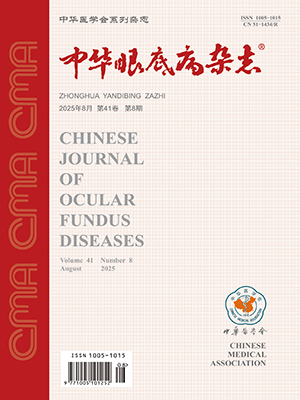| 1. |
Sapieha P, Joyal JS, Rivera JC, et al. Retinopathy of prematurity: understanding ischemic retinal vasculopathies at an extreme of life[J]. J Clin Invest, 2010, 120(9): 3022-3032. DOI: 10.1172/jci42142.
|
| 2. |
García-Aldea Á, Guillén-Yunta M, Valcárcel-Hernández V, et al. Insights on the role of thyroid hormone transport in neurosensory organs and implication for the Allan-Herndon-Dudley syndrome[J/OL]. Eur Thyroid J, 2024, 13(2): e230241[2024-03-19]. https://pubmed.ncbi.nlm.nih.gov/38417253/. DOI: 10.1530/ETJ-23-0241.
|
| 3. |
Vancamp P, Bourgeois NMA, Houbrechts AM, et al. Knockdown of the thyroid hormone transporter MCT8 in chicken retinal precursor cells hampers early retinal development and results in a shift towards more UV/blue cones at the expense of green/red cones[J]. Exp Eye Res, 2019, 178: 135-147. DOI: 10.1016/j.exer.2018.09.018.
|
| 4. |
Nicolini G, Casini G, Posarelli C, et al. Thyroid hormone signaling in retinal development and function: implications for diabetic retinopathy and age-related macular degeneration[J/OL]. Int J Mol Sci, 2024, 25(13): 7364[2024-07-04]. https://pubmed.ncbi.nlm.nih.gov/39000471/. DOI: 10.3390/ijms25137364.
|
| 5. |
Yoon SA, Chang YS, Yang M, et al. Effect of levothyroxine supplementation in extremely low birth weight infants with transient hypothyroxinemia of prematurity[J/OL]. Sci Rep, 2022, 12(1): 9717[2022-06-11]. https://pubmed.ncbi.nlm.nih.gov/35690687/. DOI: 10.1038/s41598-022-13927-2.
|
| 6. |
中国医师协会新生儿科医师分会. 早产儿治疗用氧和视网膜病变防治指南(修订版)[J]. 中华实用儿科临床杂志, 2013, 28(23): 1835-1836. DOI: 10.3760/cma.j.issn.2095-428X.2013.23.023.Neonatologist Society, Chinese Medical Doctor Association. Guidelines for oxygen therapy and retinopathy of prematurity prevention and treatment (revised edition)[J]. Chin J Pract Pediatr, 2013, 28(23): 1835-1836. DOI: 10.3760/cma.j.issn.2095-428X.2013.23.023.
|
| 7. |
中华医学会眼科学分会眼底病学组. 中国早产儿视网膜病变筛查指南(2014年)[J]. 中华眼科杂志, 2014, 50(12): 933-935. DOI: 10.3760/cma.j.issn.0412-4081.2014.12.017.Ophthalmology Group, Ophthalmology Society of Chinese Medical Association. Chinese screening guidelines for retinopathy of prematurity(2014)[J]. Chin J Ophthalmol, 2014, 50(12): 933-935. DOI: 10.3760/cma.j.issn.0412-4081.2014.12.017.
|
| 8. |
Smith LE. Pathogenesis of retinopathy of prematurity[J]. Growth Horm IGF Res, 2004, 14(Suppl A): S140-144. DOI: 10.1016/j.ghir.2004.03.030.
|
| 9. |
Vannay A, Dunai G, Bányász I, et al. Association of genetic polymorphisms of vascular endothelial growth factor and risk for proliferative retinopathy of prematurity[J]. Pediatr Res, 2005, 57(3): 396-398. DOI: 10.1203/01.Pdr.0000153867.80238.E0.
|
| 10. |
Can E, Bülbül A, Uslu S, et al. Early aggressive parenteral nutrition induced high insulin-like growth factor 1 (IGF-1) and insulin-like growth factor binding protein 3 (IGFBP3) levels can prevent risk of retinopathy of prematurity[J]. Iran J Pediatr, 2013, 23(4): 403-410.
|
| 11. |
Hellstrom A, Perruzzi C, Ju M, et al. Low IGF-I suppresses VEGF-survival signaling in retinal endothelial cells: direct correlation with clinical retinopathy of prematurity[J]. Proc Natl Acad Sci USA, 2001, 98(10): 5804-5808. DOI: 10.1073/pnas.101113998.
|
| 12. |
马小龙, 马金海, 邓林利. 胰岛素样生长因子-1在儿童生长激素缺乏症诊断中的应用价值[J]. 宁夏医学杂志, 2023, 45(7): 611-613. DOI: 10.13621/j.1001-5949.2023.07.0611.Ma XL, Ma JH, Deng LL. Application value of insulin-like growth factor-1 in the diagnosis of growth hormone deficiency in children[J]. Ningxia Medical Journal, 2023, 45(7): 611-613. DOI: 10.13621/j.1001-5949.2023.07.0611.
|
| 13. |
Liu X, Zheng N, Shi YN, et al. Thyroid hormone induced angiogenesis through the integrin αvβ3/protein kinase D/histone deacetylase 5 signaling pathway[J]. J Mol Endocrinol, 2014, 52(3): 245-254. DOI: 10.1530/jme-13-0252.
|
| 14. |
Berkowitz BA, Luan H, Roberts RL. Effect of methylimidazole-induced hypothyroidism in a model of low retinal neovascular incidence[J]. Invest Ophthalmol Vis Sci, 2004, 45(3): 919-921. DOI: 10.1167/iovs.03-0914.
|
| 15. |
Sevilla-Romero E, Muñoz A, Pinazo-Durán MD. Low thyroid hormone levels impair the perinatal development of the rat retina[J]. Ophthalmic Res, 2002, 34(4): 181-191. DOI: 10.1159/000063885.
|
| 16. |
Amato R, Catalani E, Dal Monte M, et al. Morpho-functional analysis of the early changes induced in retinal ganglion cells by the onset of diabetic retinopathy: the effects of a neuroprotective strategy[J/OL]. Pharmacol Res, 2022, 185: 106516[2022-10-19]. https://pubmed.ncbi.nlm.nih.gov/36272637/. DOI: 10.1016/j.phrs.2022.106516.
|
| 17. |
Mutapcic L, Wren SM, Leske DA, et al. The effect of L-thyroxine supplementation on retinal vascular development in neonatal rats[J]. Curr Eye Res, 2005, 30(12): 1035-1040. DOI: 10.1080/02713680500320711.
|




